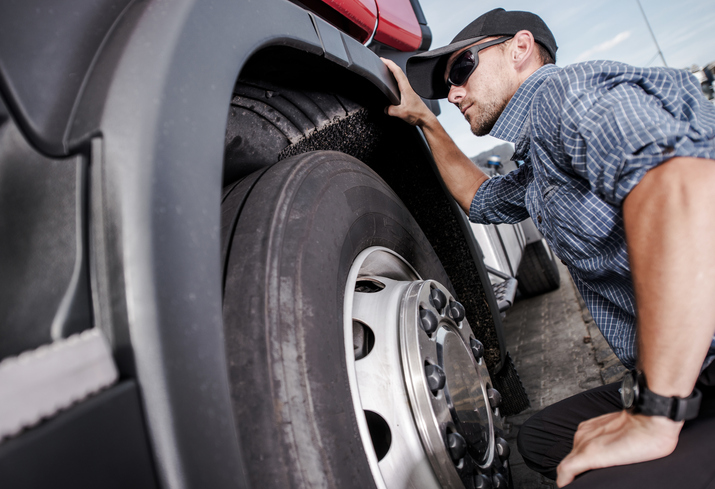Total vehicle alignment is often overlooked in preventive maintenance programs. Yet, total vehicle alignment plays an essential role in vehicle performance and in lowering operational costs. Nevertheless, industry experts estimate that 70 to 80 percent of commercial vehicles on the road today are misaligned.
Proper vehicle alignment is when a vehicle and all its tires are traveling in a straight line. Among the ways to knock a vehicle out of alignment are running over potholes, hitting curbs, bumping into concrete parking stops, and vehicle wear and tear.
Improper alignment negatively impacts vehicle safety, driver comfort, and fuel economy. Plus, it shortens the life expectancy of tires.
It’s about geometry
A vehicle not in proper alignment is a recipe for a maintenance manager’s and truck owner’s nightmare. Why? Because misalignment impacts every aspect of operating costs per mile.
Alignment refers to the various angles of steer axle geometry and to the tracking of all axles on a vehicle, including trailers. The objective of proper alignment is to minimize tire wear and maximize predictable vehicle handling and control.
Vehicle alignment settings serve a variety of functions in vehicle operation and affect such things as handling, steerability, stability, performance, and safety.
Basically, a vehicle is a composite with the chassis as the foundation. This foundation must be square and solid to support the dynamics of the complete structure.
The chassis includes every wheel, axle, suspension component, and frame member. All should be aligned in relation to one another as a whole, instead of only one wheel or one axle independently. Total alignment is a correction of the entire vehicle geometry.
Out-of-alignment occurs when the suspension and steering systems are not operating at their desired angles. When a vehicle is in total alignment, all wheels “agree” on one direction so lateral forces do not counteract.
Often, the difference between a “good” truck and a “bad” truck is simply proper alignment.
What in the World is that?
Here are some specific types of uncalled-for tread wear caused by misalignment:
- Feathering – Tread ribs or blocks are worn smooth/lower on one side and higher/sharper on the other.
- Toe – The difference in distance apart, at the front and at the rear, of the steering axle tires when viewed from directly above the truck.
- Out-of-Spec Toe-In – Fast outside shoulder wear on both steer tires because the tires are closer together in the front than in the rear.
- Toe-Out – Fast inside shoulder wear on both steer tires because the tires are closer together in the rear than in the front. (Toe settings generally have the greatest effect on truck tire treadwear.)
- Cupping – Also known as tire scalloping, this occurs because of inconsistent, distinct high and low “cup-like” wear spots, usually around the edge of the tread on one side or the other.
No good outcomes
Improper vehicle alignment impacts the two largest maintenance expenditures the most: tires and fuel. Without proper alignment, the tires will scrub across the pavement, increasing rolling resistance. Because of the lateral forces, not only is more horsepower required to move the same load (which directly impacts fuel consumption), but tire life is reduced, resulting in more frequent tire replacement.
Such unnecessary lateral forces not only require more horsepower, but also increase fuel consumption to move the same load.
Vibrations are typically caused by out-of-round tires, driveline issues, loose bearings, balance issues, or toe or drive axle misalignment.
Performing frequent alignments provides better control over vehicle condition and extends the life of the tires.
- Tracking – All axles must be aligned with the truck’s front axles, otherwise, the steer tires are forced to counter-steer against the direction of the rear axles. While the tractor alignment may be correct, a trailer tracking to the right or left (referred to as dog tracking), leads to irregular trailer tire wear as well as irregular wear on steer and/or drive tires.
- Camber – This is the tilt of the tires when viewed from the front of the truck. Positive camber is when the tires are closer together at the bottom (point of road contact), and negative camber is when the tires are closer together at the top. Positive camber causes premature treadwear along the tire’s outside shoulder, and negative camber wears away along the inside shoulder. In a tractor-trailer combination, the drive tires traditionally experience positive camber; trailer tires, negative camber.
- Caster – This is the forward or backward slope of a line drawn through the upper and lower steering pivot points when viewed directly from the side of the vehicle. Positive caster is when the line slopes towards the rear of the vehicle at the top and negative caster is when the line slopes towards the front. Caster is normally associated with handling and driveability of the vehicle and not tire wear problems. Negative caster will cause unstable steering, require constant steering corrections, and render the vehicle unable to return to straight ahead out of a turn. Positive caster causes hard steering, shimmy, and road shock.
What about the driver?
Improper vehicle alignment also impacts the driver. When a vehicle is not aligned, the driver must constantly correct the steering, usually in one direction all the time. One driver described this as a form of Chinese water torture.
Additionally, a vehicle rattling, shuddering, and vibrating along the road can cause an uncomfortable ride that contributes to driver discomfort, muscular fatigue, and stress. This tires and frustrates drivers, making them less effective and productive.
Driver fatigue caused by continuously correcting poor alignment can become a factor that impacts safety as well as the driver’s attitude. Vehicles that are difficult to handle are a reason for a driver to start looking for work with another company.
Properly aligned vehicles are not only safer to drive, they also make driving easier and more enjoyable.
Selecting a Quality commercial vehicle alignment shop
Thinking about using a commercial vehicle alignment shop? Be sure to evaluate the provider’s ability to perform an accurate total vehicle alignment. So advises the Technology & Maintenance Council (TMC), North America’s premier technical society for truck equipment technology and maintenance professionals.
TMC recommends:
- Asking maintenance shops and other truck operators and owners who they use and why.
- Getting references and checking them out.
- Asking truck dealers where they send their vehicles for alignments and why.
How deep is it?
Inspecting tires for early stage irregular wear—an indicator of alignment problems—should be part of any regular preventative maintenance practice.
The depth of a tire’s tread is one of the most obvious indications of its performance. Tread depth is also a safety issue and therefore subject to government regulation and inspection.
As defined in the Federal Motor Carrier Safety Administration (FMCSA) Regulation 393.75, Tires, any tire on the front wheels of a bus, truck or truck tractor must have a tread groove pattern depth of at least 4/32 of an inch when measured at any point on a major tread groove. The measurements are not to be made where tie bars, humps or stone ejectors are located.
The minimum tread depth for any other wheel position is 2/32 of an inch.
TMC also suggests looking for a commercial vehicle alignment shop that:
- Has ASE (National Institute for Automotive Service Excellence) certifications.
- Offers services that often go together with alignment, such as: vibration analysis, balancing, tuning, and suspension and spring services.
- Makes available value-added services like centering the steering wheel, tire rotation, and vehicle pickup and delivery.
- Wants to be a partner and is willing to develop customized specifications for one’s operation.





